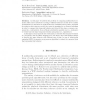Free Online Productivity Tools
i2Speak
i2Symbol
i2OCR
iTex2Img
iWeb2Print
iWeb2Shot
i2Type
iPdf2Split
iPdf2Merge
i2Bopomofo
i2Arabic
i2Style
i2Image
i2PDF
iLatex2Rtf
Sci2ools
MTA
2007
2007
A study on multimedia documents behavior: a notion of equivalence
Abstract. In this paper we address the problem of comparing multimedia documents, which can be described according to different reference models. If we consider presentations as collections of media items and constraints among them, expressed according to their reference model, they must be translated to a common formalism in order to compare their temporal behavior and detect if they have a common component (i.e., intersection), if one of them is included in another one (i.e., inclusion), or if they have the same temporal evolution along time (i.e., equivalence). In this paper, we propose the use of automata, to describe the temporal evolution of a document, and the SMIL language as a case study, since this standard allows to describe the same behavior with different sets of tags. In case of behaviorally equivalent SMIL documents, we propose an algorithm to extract the canonical form that represents this behavior.
| Added | 27 Dec 2010 |
| Updated | 27 Dec 2010 |
| Type | Journal |
| Year | 2007 |
| Where | MTA |
| Authors | Paola Bertolotti, Ombretta Gaggi |
Comments (0)

